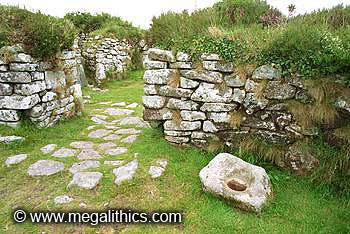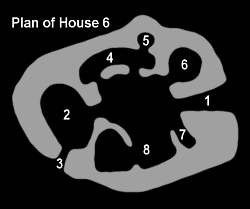
 |
|
More Pics |
|
|
VR Tour of Settlement |
|
| SW 4725 3505 (OS) |
| Visited June 2000 |
Chysauster is an Iron Age village made up of eight Courtyard Houses in two rows. It is claimed that these dwellings form the earliest identifiable village street in England. Courtyard Houses are unique to the SW peninsula and the Scilly Isles, they consist of a circular walled enclosure with buildings attached and embedded in the inner face of the wall. The buildings would probably have had thatched roofs, but the internal courtyard space would have been open to the sky.
Chysauster has been excavated many times, and some rebuilding has been carried out during each of these investigations, especially during the dig by Borlase in 1873. Because of the reinstatement, the ruins here appear much more substantial than those at Carn Euny, but it has been found that several sections of wall have been rebuilt in the wrong place. In common with the splendid example at Carn Euny, Chysauster also had a Fogou. Fogous are mysterious underground passages and chambers, the original use of which is unknown. Unfortunately, in a very unpopular move, English Heritage filled in and buried the Chysauster fogou in the 1980s, claiming that it was unsafe, we could find no trace of it during our visit. UPDATE We have recently revisited Chysauster and succeeded in locating the fogou, only the barred entrance is visible. We will post pics of this when we update the VR tour with new hi-res and aerial pics.
The houses are about 30m in diameter, and roughly circular, their internal courtyards have a diameter of about 8m. Several of the houses seem to have been built on artificial platforms that served to level their sites. The design of the houses is quite complex, but they all have broadly similar layouts, with the exception of house 3, which appears to have been a semi-detached dwelling. Of the eight houses 3,4,5,6 and 7 survive in recognisable form, but houses 4 and 6 are by far the best preserved.
 Examining
House 6 in detail illustrates the basic Courtyard House layout. The entrance (1), is on
the eastern side and opens directly into the courtyard, directly opposite the
entrance is a large room known as the “Round Room”
(2), (which is usually oval), this is thought to have been the dwelling place of the family that lived
in the house. This idea is strengthened by the existence of a second “backdoor” (3) to the
outside from these rooms in houses 3 and 6. To the left of the round room is an elongated
“Long Room” (4), with two entrances, in other houses this room may be divided into two spaces by a
low dividing wall, or is completely split into two separate rooms. In the Long Room of house 6 a
tiny additional chamber (5), is built into the outer wall, this is circular and has a raised floor,
unusually, it seems to have had a corbelled stone roof, its original function is unknown. A
small round room (6), with a paved floor that is considerably higher than courtyard is immediately the
right of the entrance. To the left of the entrance is a small chamber with a sump (7), this was
probably used to collect the rainwater that was fed to it by several stone water channels, the raised platform
built along its left side would have made access to the sump easier. The arc of wall between
this chamber and the Round Room is bare, forming a bay (8). As well as the stone water
channels, querns and hearths, large flat stones with circular depressions worked in their
centres can still be seen on the ground in several houses, these are thought to have been
footings for wooden posts supporting the thatched roofs of the buildings.
Examining
House 6 in detail illustrates the basic Courtyard House layout. The entrance (1), is on
the eastern side and opens directly into the courtyard, directly opposite the
entrance is a large room known as the “Round Room”
(2), (which is usually oval), this is thought to have been the dwelling place of the family that lived
in the house. This idea is strengthened by the existence of a second “backdoor” (3) to the
outside from these rooms in houses 3 and 6. To the left of the round room is an elongated
“Long Room” (4), with two entrances, in other houses this room may be divided into two spaces by a
low dividing wall, or is completely split into two separate rooms. In the Long Room of house 6 a
tiny additional chamber (5), is built into the outer wall, this is circular and has a raised floor,
unusually, it seems to have had a corbelled stone roof, its original function is unknown. A
small round room (6), with a paved floor that is considerably higher than courtyard is immediately the
right of the entrance. To the left of the entrance is a small chamber with a sump (7), this was
probably used to collect the rainwater that was fed to it by several stone water channels, the raised platform
built along its left side would have made access to the sump easier. The arc of wall between
this chamber and the Round Room is bare, forming a bay (8). As well as the stone water
channels, querns and hearths, large flat stones with circular depressions worked in their
centres can still be seen on the ground in several houses, these are thought to have been
footings for wooden posts supporting the thatched roofs of the buildings.
Chysauster was probably built in the first to third centuries AD, and the people who lived here were farmers, traces of their fields and enclosures still surround the village. This site was not fortified and does not seem to have the long history of occupation seen at Carn Euny.